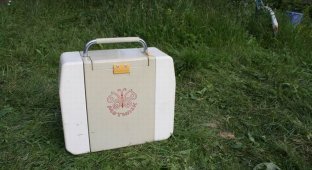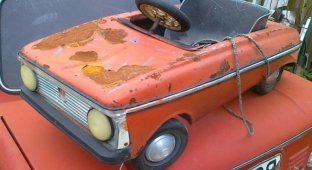A riddle from childhood: why glass balls after all (3 photos + text)
Children's treasures. Stained glass balls with a diameter of about two centimeters. Blue, green and brown balls were considered the most valuable. When they fell, the balls did not break, they only broke off pieces.
One of the main advantages of the balls was the mystery of their origin.

The balls were either found or accepted as a gift. There were several versions of the “official” purpose and origin of the balls:
1. The balls were in aerosol cans, from where they were extracted by craftsmen;
2. Balls were a method of transporting glass in containers, particularly during rail transportation.
Glass marbles served as children's currency in exchange relationships. They were also worn as talismans and, of course, used for games. There were no special rules of the game, like in the West. You just had to successfully click your fingers on your ball so that it would knock the opponent’s ball off the “field.”
Glass beads were also used by adults: in chemical institutes (to displace air from test tubes), for interior decoration (the beads were “soldered” into the walls), and to decorate aquariums.

The following are remarks from various “nostalgic” forums:
We had an airfield nearby and they said, and there was such a legend of their origin: when the plane takes off, from the friction of the landing gear on the asphalt and the enormous temperature, the asphalt and all sorts of dust and dirt on it melt and then turn glassy.
And my older brother brought these balls from the glass factory - he and his friends climbed over the fence and filled their pockets with them. They said that there were a dime a dozen of these balls, lying everywhere. I had a lot of green ones, one red one and my favorite - blue.
I remember the whole yard went out onto the railway to search for these balls. We were there quite rarely and with great joy. And for us, such balls were “freely convertible currency”... and there were exchange rates... Colorless - the cheapest, dark green - 1 piece = 10 colorless, blue and milky white - at least 20 transparent pieces. We rolled these balls into holes. Whoever is the most accurate takes all the wealth
We had the following theory for the origin of these balls: at the film studio, during filming, they used them to depict especially sparkling treasures, and then, of course, they ended up in our yard somehow...
And the police came to our school and asked us to hand over glass balls, allegedly they were poisonous. I just don’t think anyone would send the police to conduct conversations in every classroom. Of course, no one handed it over.... But maybe radioactive waste was transported this way? We found them on the railway, in all shades of blue and green.
The main and original purpose of these glass balls is TATTING. Or rather, the balls themselves are tumbling bodies.
Tumbling bodies are used in the processing of measuring, medical and plumbing tools; parts of cars, motorcycles, bicycles, watches; cutlery; turbine blades; propellers; gears; hardware; hardware; ferrites; porcelain insulators; sanitary fittings; chains; cutlery; buttons; prosthetic parts; furniture, shoes, etc. metal fittings and much more.
Tumbling bodies are used as a filler when processing parts to remove burrs, rust, scale, blunt edges, reduce roughness, surface hardening:
in rotating drums of various types (rotary, cantilever, sealed, perforated, planetary, etc.); in vibrating containers, where instead of rotation, vibration is used in 2 or 3 directions, which ensures the processing of fragile and small parts without damage.

Glass beads are molded spherical products made by boiling quartz sand, fluorspar, limestone, alumina, boric acid, etc. in a glass melting furnace at high temperature. Glass beads are made with a diameter of 22 ± 1 mm. They contain boron oxide (B2O3), the mass percentage of which is at least 7%. According to their physical and chemical properties, glass beads are not toxic, explosive, or flammable. These neutral characteristics allow glass beads to be used quite widely. Glass beads are a semi-finished product, the starting material for the production of glass fibers for various purposes, the production of woven and non-woven fibers. Glass beads are also used for the dispersion of solids and liquids (especially often in bead mills). Soft Big-Bag containers intended for transportation and storage of bulk cargo are used as packaging for glass beads.
Source: users
























